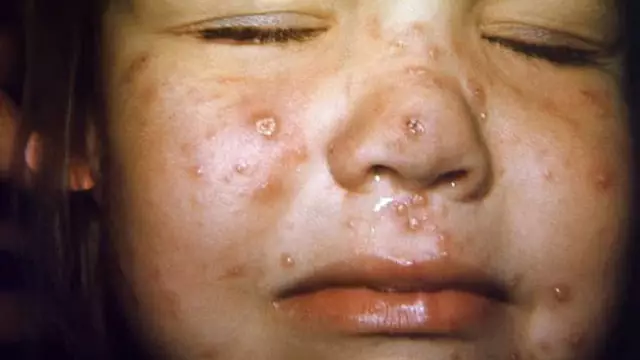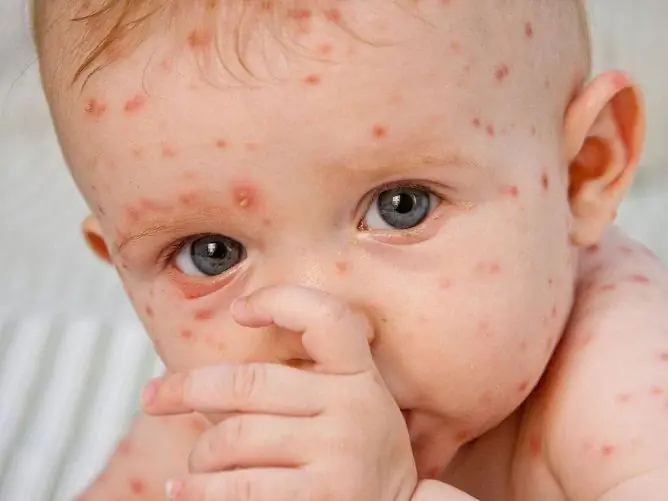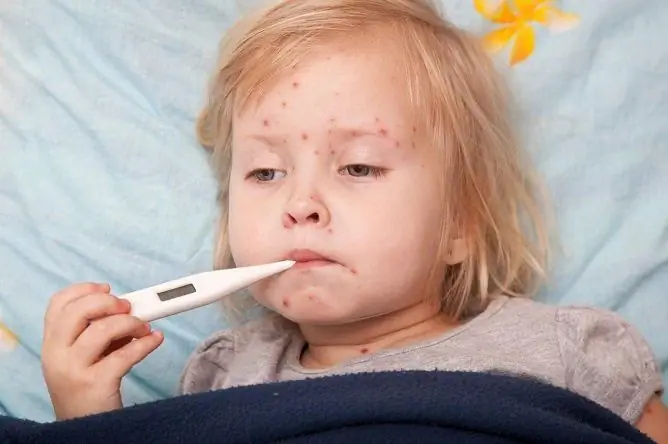- Author Rachel Wainwright [email protected].
- Public 2023-12-15 07:39.
- Last modified 2025-11-02 20:14.
Chickenpox in adolescents

As a rule, chickenpox or chickenpox, as it is called in medicine, people get sick in childhood. In this case, the disease proceeds without any particular complications and much faster, and with age, its manifestations become more severe and can lead to serious consequences. Therefore, chickenpox in adolescents has specific symptoms that cause great inconvenience to patients, and often causes various complications.
Chickenpox symptoms in adolescents
The main difference between adolescent chickenpox and this disease at a young age, as noted, is the more severe form of the disease. The varicella-zoster virus is transmitted by airborne droplets mainly in places of mass stay of people (schools, cinemas, swimming pools, etc.), and this leads to the fact that the disease in children often passes en masse.
The severe form of chickenpox in adolescents is primarily due to the active processes of physical and hormonal changes in the body during this period. They increase the sensitivity and vulnerability of the body, which leads to susceptibility to viruses and reduces resistance to infections. Against the background of a weakened immunity, these factors only aggravate the patient's serious condition.
The symptoms of chickenpox in adolescents are very similar to those of acute respiratory infections:
- Temperature increase;
- Chills;
- Runny nose;
- Attacks of headaches.
These manifestations of the disease occur about a day before the rash on the skin, which is the main symptom of chickenpox in adolescents. It is important to note that the disease becomes contagious much earlier. Skin rashes in patients can also be accompanied by severe itching, which causes a constant urge to scratch the blisters. They spread very quickly throughout the body, but in no case should you touch, squeeze or scratch the rash, since there is a high risk of infection in the wound.
This symptom of chickenpox in adolescents usually affects the entire skin already on the 5-7th day of the disease, and within 10 days there is the possibility of a second rash. The blisters then dry up and crust over 10-14 days after the onset of the illness. These crusts remain on the skin for a couple of weeks, after which they gradually disappear, leaving small pinkish spots. After some time, such spots decrease in size and disappear, as a rule, by themselves.
It should be noted that the peak of the formation of skin rashes with chickenpox is characterized by an increase in temperature up to 38-40 degrees, and this often causes severe intoxication of the patient's body. In addition, the rash is also localized on the mucous membranes (in the nose, tongue, palate, bladder, urethra, etc.).
Additional symptoms of chickenpox in adolescents include the following:
- Muscle pain and muscle twitching;
- General weakness and lethargy of the body;
- Sleep disturbance;
- Swollen lymph nodes;
- Photophobia.
Complications after chickenpox in adolescents
As noted above, complications after chickenpox in adolescents are much more common than in young children who have contracted this virus. This is due to the specific characteristics of the organism at this stage. Therefore, hormonal changes inherent in the period can easily provoke such purulent complications of chickenpox rash as:
- Fasciitis;
- Pyoderma;
- Phlegmon;
- Abscess.
Another complication after chickenpox in adolescents is the formation of scars and age spots at the site of the blisters. Such consequences occur due to scratching of the rash, when bacterial infections get into the scratching. It can also provoke skin lesions such as gangrenous and hemorrhagic phenomena.
Separately, it should be said about the complications after chickenpox in adolescents, proceeding in a severe form. They are characterized by the formation of large blisters filled with fluid, in the place of which ulcers remain that are difficult to heal. The gangrenous form of chickenpox occurs in adolescents with a weakened body. Symptoms include rapidly growing blisters with bloody fluid inside. After drying, the crust on them is black with inflamed tissue along the edges.
The hemorrhagic form of chickenpox is observed with blood clotting disorders. Blisters also contain bloody fluid. Complications of this form can be skin hemorrhages, nosebleeds, etc.
Chickenpox treatment in adolescents
Treatment of chickenpox in adolescents is practically no different from the treatment of this disease in children. First of all, in order to avoid all sorts of complications, it is necessary in every possible way to refrain from scratching the rash. For this purpose, blisters are smeared with brilliant green or fucorcin, which reduce the feeling of itching and help them dry out. In addition, in order not to infect the wounds, the places where the rash forms are treated with antiseptic agents.

In the treatment of chickenpox in adolescents, antiallergic drugs such as fenistil and suprastin are often used, as well as immuno-strengthening agents (for example, Viferon suppositories). Often with chickenpox, it is necessary to use antipyretic drugs, which are recommended at temperatures above 38 ° C. Doctors advise to refrain from using aspirin and use medications containing paracetamol. It is safe for the health of a teenager and has good anti-inflammatory and antipyretic effects.
Effective treatment of chickenpox in adolescents also involves the constant use of fluids, dairy and herbal products. It is important to know that it is impossible to wet the chicken rash, therefore bathing during the period of illness is strictly not recommended, with the exception of taking baths with potassium permanganate, which help reduce itching. Otherwise, the rash will heal very slowly. Only intimate hygiene is allowed. Doctors often recommend diazolin to relieve itching.
With chickenpox in adolescents, strict bed rest and complete isolation are necessary, since the disease is very contagious and requires quarantine.
YouTube video related to the article:
Found a mistake in the text? Select it and press Ctrl + Enter.






